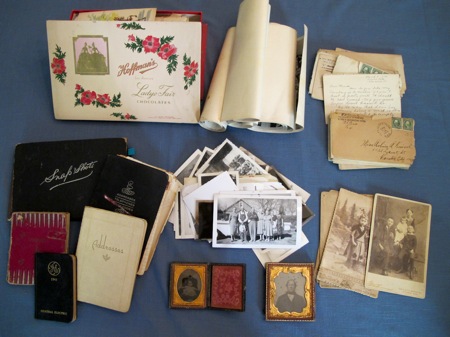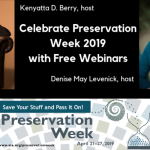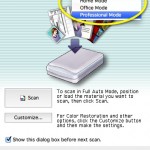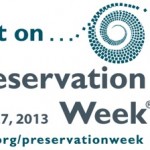
Should I keep this? Anyone who has cleaned out a family home or helped settle an estate has probably heard this question more than once.
It can be hard for family historians to let go of anything that might carry a family story, no matter how old or broken that keepsake might be. One keepsake isn’t much to save, but it doesn’t take long for family treasures to become a mountain of memorabilia that threatens to come down on our present life like an avalanche.
Should I keep the silverplate coffee service that no one likes and will use?
Should I keep grandpa’s Army uniform?
Should I keep these old address books? Christmas cards? Bank books?
So, how do we choose, what to save, what to toss, and what to give away? I’ve sifted, sorted, and organized dozens of family collections, and discovered that it sometimes “less” is truly “more,” even when it comes to family archives. Yes, we could probably find a family story in every single item set aside and saved, but is that the story we want to preserve? Or, knowing the story, can we let the item go?
Our ancestors were mobile people, and as anyone knows who has ever moved from home to home, each relocation typically involves a kind of triage. Some things are tossed away, others carefully packed up and moved to the new home. Rarely is a home moved intact from place to place.
The same kinds of decisions occur between generations. Sometimes, a son or daughter will inherit an entire home of possessions and need to begin the difficult task of sifting, sorting, saving, and tossing.
Family historians will want to be on the lookout for anything that documents vital record information (birth, marriage, death records), hints at unknown family members, or fills in the blanks for “mystery years” or “family secrets.”
So, what should what should we keep, and what can we toss or give away?
It depends.
An unhelpful answer, I know, but it does. . . depend.
It depends on how many family collections you have already and how many more you are likely to bring home in the future. – If you have a good storage archival storage space and the time and interest to organize and preserve the items, feel free to save whatever you like.
It depends on the size of the collection.
A box filled with family artifacts vs. an entire family home with everything, including the kitchen sink. You might decide to save everything in the box, and be selective when it comes to the house.
It depends on your relationship with the owner.
This is not to say that treasures belonging to a favorite aunt are of less value than those belonging to a parent or grandparent. But if you have six aunts and uncles and inherited everything from all of them, you might be wise to be selective about what you preserve in order to allow space, time, and resources for your direct ancestors’ collections,
It depends on why it was saved.
Did your ancestor save that old hairbrush to brush the dog, or was it a treasured item brought from the Old Country? Not every artifact has value as a family heirloom. It might be interesting, old, or unique, but is it worthy of your preservation efforts?
It depends on how old it is.
That old hairbrush might not look like much, but if it’s one hundred years old, I’d probably save it. I might show it to an antique expert to learn more about it. I wouldn’t want to see it in a photo one day and realize I had thrown out great-grandmother’s vanity brush.
It depends on what it’s worth, monetarily.
All things being equal, sterling silver trumps silverplate when it comes to competing for precious storage space.
It depends on what it’s worth, to me.
However, if I had to choose between them, I would save my ancestor’s pottery baby cup over a silver one. Sentiment and connection trump a dollar any day.
Seven Questions
When deciding what to save and what to toss, ask yourself –
- Do I have the resources to care for this?
- Is this the only keepsake from my ancestor?
- What is my relationship to the owner?
- Was this item saved as a family heirloom?
- How old is it?
- Is it valuable?
- Is it priceless to me or to our family?
Three “Yes” answers should be a clue that the item is worth preserving, or at least holding for further consideration.
I’ve found 19th century baby photos tucked between pizza take-out menus and trade union cards stashed in old wallets. You have to look inside everything, but then it’s ok to toss the cracked plastic envelope, the take-out menus and the smashed, blackened prom corsage.
Take a digital photo if you need a visual reminder of the artifact. Write a short note if it holds a special story. If in doubt whether or not you should let something go, ask yourself if you’ve ever saved a similar memento from your own life experience, and what you expect your children to do with it. Sometimes, it’s ok to give yourself permission to hold on to the memory and let go of the clutter.
Find more ideas for sorting and organizing inherited family treasures in How to Archive Family Keepsakes: Learn How to Preserve Family Photos, Memorabilia & Genealogy Records by Denise May Levenick (Family Tree Books, 2012).






Shelly, you might take some of those 'cool stuff' and make a shadow box (available at large craft stores, Michael's, JoAnn's) and then you could hang it on a wall and enjoy everyday.
This is a well written article. Sorting through family heirlooms, memorabilia or general belongings of a lost loved one can be a very emotional exercise. These tips if kept in mind throughout the process make for a more practical and decisive approach.
We loved this article and featured it on FamilyHistoryReport.com. Your focus is very much what we are promoting: preserve family history FIRST. http://www.familyhistoryreport.com/blog/chuck-cherish/
Shelley – Good luck working with your Mom's keepsakes. When we did this with my mom's and my aunt's things I kept too much — but it's easier to let it go later sometimes, and impossible if it's already gone. I did allow myself one box of "cool stuff." I filled it with vintage greeting cards and bits of ephemera I liked. I don't know if I will keep it forever, but it's definitely fun. Let me know how it goes. ~ Denise
Fran, You have quite a project ahead. Have you considered making a digital copy of each book? I've done this with several photo/scrapbook albums and it goes pretty quickly once you set up your equipment. I used a digital camera on a tripod and photographed each page. Some pages with info or great photos I did a zoom photo of the single items. I've also placed buffered interleaving paper between the pages to help protect items. You could use thin rag paper too.
Let me know if you need more ideas. It sounds like a big project, so my advice is to keep it simple and just get it done! And I like your idea to offer the books to the historical society. They could be a treasure trove to local researchers!
Keep me posted on your progress. ~ Denise
These are tremendous guidelines! I love this post so much I blogged about it today on Organize Your Family History.
This is such a helpful post, Denise! I'm currently in the process of helping my mom sort through a lifetime of possessions in preparation for a move. We're struggling with these very issues, so it's really good to know what questions to ask ourselves, and that it's ok to give some things away. I'm using your book to help me organize and preserve the things I do end up bringing home, and it's a big help.
Great advice. Now I just need to apply it!
We have scrapbooks created by my husband's paternal grandmother and her daughter (his favorite aunt). There are 72 of them, and most have family history writings and mementos. We've gone little farther than separating them into decades (1900s to 1950s — and some of the 1900s books contain family treasures from as far back as the 1850s). All but a few scrapbooks are in terrible condition after years of sitting in a damp basement. (We rescued them when the son of the favorite aunt was tossing them into a dumpster!) The scrapbook pages crumble around the edges..
Our plan is to go book by book, page by page, and "catalog" what each book contains. I'll list everything (for example, "gg grandparents' wedding invitation" but sometimes in generic terms, for example, "pictures of nature clipped from magazines"). We'll probably scan significant family history items as we go.
Once I get through all 72 (if, indeed, we DO!), we will have choices to make:
1. Show what we have to the Kentucky historical society and offer them the books that they want, then toss the rest. (These books tell the story of one Ohio-and-Kentucky family through 6+ decades and 5+ generations, and KHS has expressed interest.)
2. Remove significant family letters, cards, narratives, memorabilia from the old books and put them in new, archival albums and keep them in the family.
3. Save the scans and toss the books.
We're fairly overwhelmed, so maybe I need to read your books again! We are at the start of this long-term process and would appreciate any advice you wish to share. Thanks.